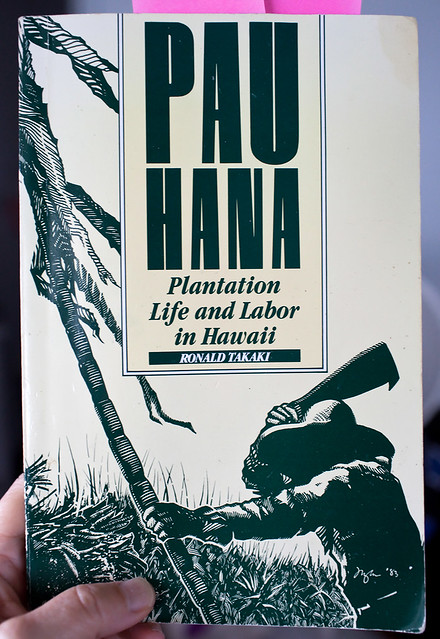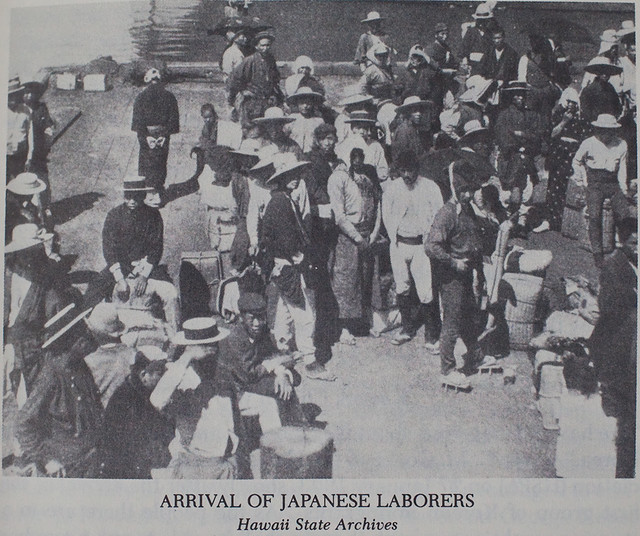I got this book at the swap meet called Pau Hana, Plantation Life and Labor in Hawaii, 1835-1920, written by Ronald Takaki.

I found the parts that were related to my great grandparents most interesting. Below is an excerpt.
Hawaii Netsu
The Japanese described it as "Hawaii Netsu"--the emigration "fever" sweeping through the southwestern prefectures of Yamaguchi, Fukuoka, Kumamoto, and Hiroshima in the 1880s. In small villages, recruiting agents for emigration companies depicted Hawaii as a land of eternal summer where people were sincere and gentle by nature" and "very kind towards strangers." Everyone it seemed, talked excitedly about going to the islands. Many prospective emigrants imagined bold possibilities for themselves in Hawaii, the place where they would be able to fulfill dreams of making money and building bright new futures.
Most of the Japanese emigrants were not poor. They were small farmers and tenant farmers, but they were experiencing mounting economic hardships. The southwestern prefectures were in economic difficulty in the late nineteenth century. Many villagers were subsisting on tree barks and roots and others were starving to death. Food was becoming scarce in the densely populated prefectures. "The depression of trade in Japan has increased month by month and year by year, showing no signs of abatement," editorialized the Japan Weekly Mail in December of 1884. "It seems to have come to a climax during the autumn of the present year, for the distress among the agricultural class has reached a point never before attained. Most of the farmers have been unable to pay their taxes, and . . . hundreds of families in one village alone . . . [have been] compelled to sell their property in order to liquidate their debts."
The future in Japan seemed bleak for these farmers in the southwestern prefectures, and the Hawaii Netsu seized many of them. They saw Hawaii as an alternative to moving to the cities in Japan, where they would be inducted into factory labor and forced to live in congested urban housing. Financially distressed farmers saw the Hawaiian Islands as an opportunity to earn a livelihood. Hopefully, as dekasegi, laborers who would leave home temporarily to work in a foreign country, they might even succeed in saving one or two hundred dollars by working for three years in the sugar fields and build a nucleus of capital for future enterprise. Indeed, they might even be able to save enough money to purchase land in Japan and become farmers in their homeland once again. Three years of hard labor in faraway cane fields; three years of separation from friends, family, and village seemed to be a small sacrifice to make for the realization of such an ambitious dream.
And so thousands of Japanese agreed to become contract laborers and to work in Hawaii for three years for $9 a month, plus food, lodging, and medical care. Their passage to Hawaii was to be paid by the sugar planters, and they agreed to have 25 percent of their wages deducted from their earnings and deposited in a savings fund for their return passage to Japan. They were told they would be able to save 400 yen in three years. The notion of accumulating so much money in a small span of time had electrifying appeal to people who knew that a silk mill worker would be able to acquire such a sum only if she worked every day for ten years and saved all of her wages. Thus Hawaii symbolized a new beginning for many farmers, and when the government of Japan announced its intention to fill 600 emigrant slots for the first ship to Hawaii in 1884, it received 28,000 applications.
On January 20, 1885, the initial group of immigrants boarded the City of Tokyo at Yokohama: 666 men, 158 women, 69 boys, and 48 girls. After the ship had been quarantined for a week at Nagaura, it set sail on January 27. The vessel, as reported by Consul Jiro Nakamura "encountered no storms or rough weather," but "did not sail well due to winter seas. There were some who suffered seasickness as well as from other chronic ailments. There were two doctors on board who diagnosed and treated the ill. In addition to the customary Japanese dishes, special rations of milk, noodles, and rice cakes were served to the immigrants on their voyage across the ocean."
"The manpower shortage in this nation is such that all our people were assigned employment within a few days after arrival," reported Nakamura. "I have heard that many employers have been unable to have their requests filled and are anxiously awaiting the arrival of the next batch of emigrant laborers . . . . ". The processing was done efficiently and quickly, and by February 23 all of the immigrants had left Honolulu, obligated by labor contract to three years of plantation labor. Meanwhile planters waited impatiently for the "next batch" of Japanese laborers.
Many more batches of laborers from Japan would arrive in the islands as the Hawaii Netsu evoked dreams of hopes among the people of the southwestern prefectures and as the Sugar Kingdom demanded more and more labor. After 1887 Japanese laborers paid for their own passage to Hawaii--an expense of two hundred yen, or about a hundred dollars. This meant one had to be at least a member of the farming middle class to be able to afford to work in Hawaii. Still they came. By 1924, forty years after the first group had been enlisted as plantation laborers for passage on the City of Tokyo, over two hundred thousand Japanese had migrated to Hawaii.



















19 comments:
Thank you so much for honoring Hawaii's people with this great post! Aloha Dear
Interesting!
This definitely relates to my father's side of the family also. I grew up in plantation housing.
Wow,how interesting! My ignorance would never see Japan as having bleak times like this. Interesting!
Awww, thanks Cloudia!
Totally yah, Mich.
Kay, I wish I could go back in time and meet my great grandparents and show them what our life is like today.
Susan, how many generations back does your family go?
j: We literally stand on the shoulders of the ones before. Yes, conditions were very bad in Japan during their time and some of the recruiters also blatantly lied to them. But we are one of many immigration groups, each one enduring hardship hoping for the next generation to do better, to be more. And each group slowly did, doing the more difficult, manual labors that most do not want to do. The story continues today with each new ethnic group arising from the same conditions. I wonder how life was for my paternal grandparents struggling in Kona after they ran away from a bad luna. My dad had some interesting tales! -N
Great history lesson, thanks!
We (Japanese Canadians) can relate -- many immigrated to Steveston, British Columbia long,long ago for the abundent salmon fishing!
I'm reading about those bad lunas, N . . . with whips and all.
My pleasure, Aunty!
OMG Julie, that's so interesting.
wow, interesting yah!
Awesome find Jalna! Keep on Shopping! ; )
Tough times. My grandparents were farmers, they gave their farms to relative and came to Hawaii. I never knew why, this explains the bad times and their decision to come to Hawaii. Thanks for the great history lesson.
They sell it on Amazon for $10. http://www.amazon.com/Pau-Hana-Plantation-Hawaii-1835-1920/dp/0824809564/ref=sr_1_1?ie=UTF8&qid=1460788064&sr=8-1&keywords=Pau+Hana%2C+Plantation+Life+and+Labor+in+Hawaii
I think so too, Les!
Thanks, Mark.
Me too, Erick. I always wondered.
Jalna is such a good Shopper! I do now herby declare her "The Shoppenator"....! ; )
I would have to research for a long time because I do know we all go back to Adam and Eve : )
nice!
Jalna, this is so fascinating! Thank you for sharing!
I'm back in US a few days ago from Japan... Our grandson and daughter-in-law were sick with influenza so we just helped them out making meals and did errands the first week. The trip didn't go as we planned but we still had a great time. Food there is so delicious that I gained a few pounds. I saw a packaged 6 decopons for 8,000 yen! Crazy!
Welcome back, Akemi!! Too bad that grandson and daughter-in-law were sick. 8,000 yen for 6!! Wow!!
Post a Comment